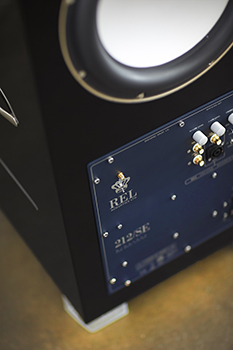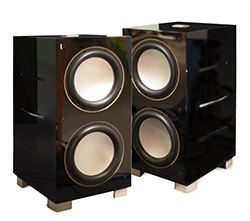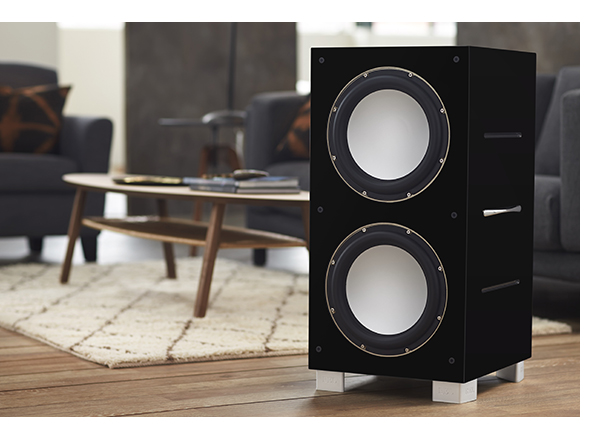As REL’s John Hunter will tell you, you need a pair of 212SEs to disappear in your room, and that is the ultimate goal of a sub-bass system, to prove a transparent extension to your main speakers, never drawing attention to themselves. While the uninitiated might opt for small cubes that can be placed a bit more out of the way, Hunter explains it succinctly: “When you hear low-frequency information out in the real world, it doesn’t just come at you from off in the corner, it envelops you from all directions.” Thus, the height factor of the 212SE is equally important to disappear audibly.
After Hunter spends a bit of time optimizing my Focal Sopra no.3s for perfect positioning, blending the 212SEs into the rest of the system takes place quickly. When complete, the subs are impossible to localize, and in addition to the lower register improving dramatically, the entire presentation takes on greater depth, width, and height. The Sopra no.3s and the 212SEs work together as one. Perfectly.
As the music is playing, Hunter says, “Ok, now we’re listening to about $300k worth of gear, right?” Then with a quick flick of two switches and a wry smile, he turns the 212SE’s off and says, “Now we’re listening to $292,000 worth of gear.” The difference is staggering; the soundstage completely collapses. Considering the $8,000 that a pair of 212SEs will set you back, won’t even buy a power cord from some manufacturers, this is amazing. The delta achieved by including the pair of 212SEs in my reference system is more than just a 100% jump, I no longer can listen to the system without them in. Adding a pair of these subwoofers to get this improvement for less than 3% of the total system cost is unbelievable.
It’s not the bass; it’s everywhere
The level of depth that the pair of 212SEs adds to the mix is just as exciting as the low-frequency extension. The delicacy of the opening Fender Rhodes licks in the Springsteen classic “Kitty’s Back,” waft through space between my Focal Sopra no.3s so gently, it sounds better than when I’ve sat ten feet away from one in a club. This stunning realism is the key to the 212s presentation. As it says on the REL website, their goal is to restore midrange warmth and harmonic structure. This deceptively simple goal, nearly impossible to achieve, is a promise that has never been delivered in my listening room until now.
Tracking through myriad cuts deliberately lacking substantial LF content reinforces the initial experience. Whether listening to Ella Fitzgerald or Eddie Mercury, my system has more bloom, more dimensionality. The music comes alive in all dimensions more clearly, with more low-level information present at all volume levels. Enticing as giving the volume control a hearty spin is, it’s still good at low volume.
These subwoofers have been a serious threat to productivity. The experience they’ve added to my primary reference system keeps me glued to the listening chair, at times for hours, at times for the entire day. With so much more musical information available, listening becomes sheer joy again.
It’s almost better than real
Because of the power required, lower frequency extension and detail is usually the first thing to give up the ghost when pushed, followed closely by overall system imaging. Depending on your room, system, and available power, it happens gradually or in a brick wall fashion. For the first time in nearly 40 years, this didn’t happen, no matter how loud the music was. The REL 212SEs offer no trace of distortion, compression or fatigue. Even when hitting nearly 120db peaks in my 16 x 25-foot listening room.
Fun as this is, be careful should you attempt this at home, OSHA says you should not be exposed to music at this high volume level for more than about 10 minutes. Just enough to listen to Pink Floyd’s “Breathe” in a way I’ve never experienced it – not even live. Whether you jump off the cliff for a pair of 212SEs or even one of REL’s smallest offerings, the musical force that comes with having a great sub-bass system will make it tough, if not impossible to go back. You can’t unhear it.
Inside the black box
We can go on and on about the tech inside the 212SE, but from the listening chair, it’s all about execution and level to detail. That’s why the 1.6-liter engine in a Kia makes 150 horsepower on a good day, and the 1.6-liter engine in a contemporary F1 car makes almost 900. Make no mistake, REL is the Ferrari F1 of low-frequency reproduction. Full specs are available on the REL site here: https://rel.net/shop/subwoofers/serie-s/212se/
The 212SE looks conventional from a distance, a big black box with woofers in the front. A closer look reveals that the two front-firing 12” continuous cast active drivers are paired to an additional 12” passive cone on both the rear and bottom. The passive cones use the same material as the active drivers, providing sonic consistency. REL claims that the two passive drivers not only add dimension to the bass produced giving the 212SE the equivalent of a pair of 17-inch drivers. Driving each of these woofer arrays is a 1,000-watt amplifier, optimized for its job.
Closer inspection reveals numerous fine details; the finish is exquisite. Not only is it the equivalent of anything I’ve seen on a six-figure pair of Wilson or Magico speakers, but it’s also the equivalent of anything I’ve seen on a Bentley. The gloss black on the review 212s is liquid in appearance, and this reflective quality helps it to physically disappear in the room. Even the complexity of the machined shape in the side handles reveals a level of attention that tells you this is indeed a special product.
 For those not familiar with REL, they use a speaker level connection, requiring your main speaker’s run full range, so the signal going to the subs has the same sonic signature of what is going to the mains via your power amplifier. They can be used via line level inputs as well, but whenever I’ve tried this with a REL subwoofer, the results were never quite as good as doing it their way.
For those not familiar with REL, they use a speaker level connection, requiring your main speaker’s run full range, so the signal going to the subs has the same sonic signature of what is going to the mains via your power amplifier. They can be used via line level inputs as well, but whenever I’ve tried this with a REL subwoofer, the results were never quite as good as doing it their way.
Should running a cable be inconvenient, REL subwoofers can also be connected via their Longbow wireless transceiver. The Longbow is a compression-free wireless system, utilizing the same speaker or line level outputs, transmitting wireless information effortlessly. While this option was not taken here, it has been used with other REL products with excellent result.
And the winner is
The combination of dynamics and musicality that a pair of REL 212SEs add to the mix is of such high quality, I had made up my mind after about 10 hours of listening (I was up until about 4 a.m. after Hunter left, the day he installed them) that this would be our product of the year. For my money, this could be TONE’s product of all time.
I’ve had the privilege to own and evaluate thousands of components in the last two decades. Nothing has ever come close to achieving so much at such a modest cost. $8,000 is by no means chump change, but when other companies are asking ten times this for wire, that they claim is a “component level” upgrade, I call shenanigans. If your system doesn’t go to 11 right now, a pair of these will get you there. And if it already does, hang on; you’re still in for a ride you aren’t expecting.
In the end, I’m not sure what freaks me out more, that a pair of REL 212SEs are this good, or knowing that there are two more models above the 212SE.
$4,000 each, two used in this review
Peripherals
Analog Source Grand Prix Audio Monaco 2.0w/triplanar arm, Lyra Etna
Digital Source dCS Rossini DAC and clock
Main Speakers Focal Sopra no.3
Preamplifier Pass Labs XSPre
Phono Pass Labs XSPhono
Amplifiers Pass Labs XS 300 monos, XA200.8 monos
Cable Cardas Clear, Tellurium Q Black Diamond
Racks Grand Prix Audio Monaco





















